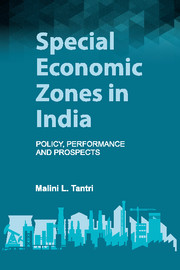Book contents
- Frontmatter
- Contents
- List of Tables, Figures, Charts and Maps
- Preface
- Acknowledgements
- Abbreviations
- 1 Introduction
- 2 Export Processing Zones to Special Economic Zones: Trajectories of Policymaking
- 3 China's Experience with Special Economic Zones under a Liberalized Regime – Highs and Lows
- 4 Performance of Special Economic Zones: Promises, Realizations and Paradoxes
- 5 An Assessment of the Fiscal Viability of Special Economic Zones
- 6 Special Economic Zones and the Question of Efficiency
- 7 Conclusions
- Bibliography
- Index
3 - China's Experience with Special Economic Zones under a Liberalized Regime – Highs and Lows
Published online by Cambridge University Press: 13 September 2017
- Frontmatter
- Contents
- List of Tables, Figures, Charts and Maps
- Preface
- Acknowledgements
- Abbreviations
- 1 Introduction
- 2 Export Processing Zones to Special Economic Zones: Trajectories of Policymaking
- 3 China's Experience with Special Economic Zones under a Liberalized Regime – Highs and Lows
- 4 Performance of Special Economic Zones: Promises, Realizations and Paradoxes
- 5 An Assessment of the Fiscal Viability of Special Economic Zones
- 6 Special Economic Zones and the Question of Efficiency
- 7 Conclusions
- Bibliography
- Index
Summary
Background
The articulation of a hard-nosed policy with respect to SEZs is of special significance among the various measures introduced by the Deng Xiaoping government, to liberalize the external sector of the Chinese economy. Although this policy shift among others was aimed at testing seeds of capitalism (Zeng, 2011) within a rigid socialistic framework, once set up, these economic enclaves began acting as prime engines of the economic transformation of China in the post-reform period, and subsequently, gained worldwide attention and even widespread emulation. Apparently, a few economies that were keen observers of the development path of China's economic reform, including India,1 tried to replicate similar reform strategies. However, the replication of the Chinese model of SEZs in the Indian context led to certain set backs, raising questions regarding the appropriateness of experimenting such a measure.2 In fact, the concept of SEZs in India was received with more scepticism than expectations in India. In this context, it becomes imperative to ask and understand why and how a certain policy implementation that was stunningly successful in one country turned out to be incapable of meeting the expectations upon its emulation in another. This requires a two-pronged approach: (a) to understand the conceptual rigor, pragmatic tenor and a flawless implementation of the SEZ policy in China before delineating carefully the factors that allowed and even facilitated such an implementation; and (b) to analyse, in retrospect, the SEZ expansion trajectory in the context of Chinese economy in addition to addressing issues such as the effectiveness of SEZs in transforming a traditional economy into a modern one and quantifying the challenges and economic set backs of SEZ expansion in China. Thus, an exploration along the following these lines, is crucial to understanding the success story of SEZs in China: (a) to identify factors contributing to the success of the Chinese SEZ policy, as also various supportive mechanisms, both internal and external, that have played an important role in scripting this success story; (b) to identify the inadequacies in the way Indian policymakers understood the demands underlying such a policy shift and its implementation, and also the institutional and infrastructural requirements that should have been provided for its emulation; and (c) to identify the lessons that India can imbibe in its attempt to redefine the SEZ policy, which, doubtless, has become a necessity now.
- Type
- Chapter
- Information
- Special Economic Zones in IndiaPolicy, Performance and Prospects, pp. 45 - 84Publisher: Cambridge University PressPrint publication year: 2016



